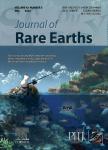Fabrication and characterization of YVO_4:Eu^(3+) nanomaterials by the microwave technique
Fabrication and characterization of YVO_4:Eu^(3+) nanomaterials by the microwave technique作者机构:Institute of Materials ScienceVietnamese Academy of Science and Technology University of Engineering and TechnologyNational University Hanoi Departments of ChemistryHanoi University of Mining and Geology
出 版 物:《Journal of Rare Earths》 (稀土学报(英文版))
年 卷 期:2011年第29卷第12期
页 面:1137-1141页
核心收录:
学科分类:0709[理学-地质学] 0819[工学-矿业工程] 07[理学] 070205[理学-凝聚态物理] 08[工学] 0708[理学-地球物理学] 080501[工学-材料物理与化学] 0805[工学-材料科学与工程(可授工学、理学学位)] 0703[理学-化学] 0702[理学-物理学]
基 金:Project supported by Vietnam's National Foundation for Science and Technology Development (NAFOSTED) (103.06.46.09) part of Vietnam Basic Research Programming for Application (2/2/742/2009/ HD-DTDL)
主 题:microwave synthesis method DEG soft template YVO4:Eu^3+ nanophosphor luminescence rare earths
摘 要:Fabrication and characterization of YVO4:Eu^3+ nanophosphors prepared by microwave (MW) irradiation assisted soft template synthesis were reported. The effects of synthesis conditions such as different powers of MW irradiation, pH values and concentration of reac- tion materials on properties of nanophosphor were also investigated to obtain the controllable size, morphology and high luminescence efficiency. Morphology, crystalline structure, and optical properties were characterized by field emission scanning electron microscopy (FE-SEM), X-ray diffraction (XRD) and fluorescence spectroscopy, respectively. The results showed that YVOa:Eu^3+ nanophosphors were obtained by using diethyleneglycol (DEG) as soft template, with pH values in the range of 4 to 12, upon microwave irradiation from 300 to 900 W, at temperature of 80 ℃. The high fluorescent YVOa:Eu^3+ nanocrystals obtained with size from 15 nm down to 8 nm are more effective to develop an ultrahigh sensitive fluorescent label for biomolecule, cell and tissue.



